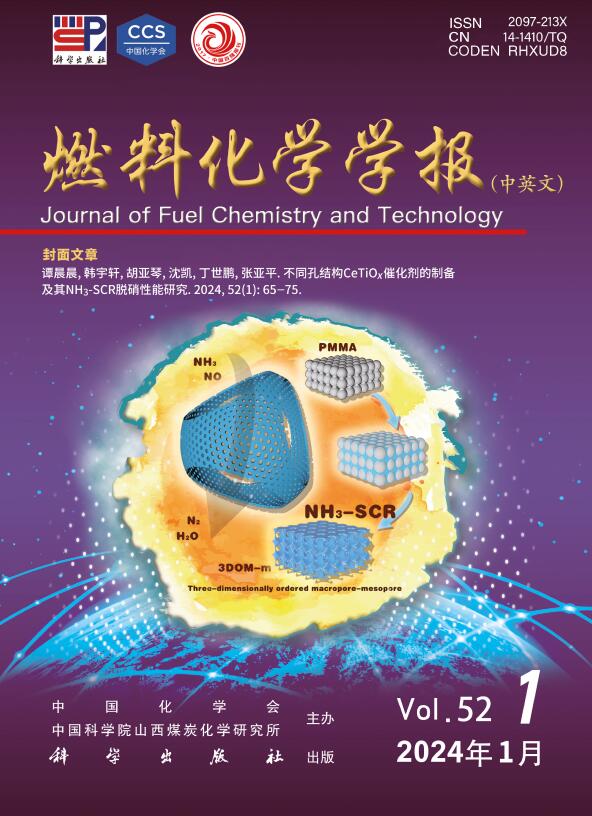从理论角度理解受挫Lewis对在CeO2(110)上催化C=C和C=O选择性加氢反应的机理
Q3 Energy
引用次数: 0
摘要
非均相固体挫折路易斯对(FLP)催化剂在实际加氢应用中具有广阔的应用前景。研究发现,通过表面氧空位调控,可以在二氧化铈上形成全固体FLPs。因此,希望研究flp催化C=C和C=O加氢的机理,并为CeO2催化剂的选择性加氢改性提供见解。本文以经典的Lewis酸碱对(CLP)位点为参考,利用密度泛函理论(DFT)研究了CeO2(110)表面FLP位点上CH2=CH2和CH3CH=O的加氢反应机理。结果表明,在CLP位点,解离氢化物(Hδ−)与表面O原子形成稳定的H−O键,而在FLP位点,Hδ−被Ce稳定,表现出较高的活性。另一方面,Ce原子在FLP位点的电子云密度更高,可以将更多的电子转移到吸附的CC=C和OC=O原子上,导致C=C和C=O键的激活程度更高,这是Bader电荷分析的结果。因此,与CLP位点相比,FLP位点对CH2=CH2和CH3CH=O表现出更高的加氢活性。此外,在FLP位点上,它对CH2=CH2的加氢具有较高的催化效率,其决定势垒为1.04 eV,但对CH3CH=O的加氢具有有限的催化活性,其决定势垒为1.94 eV。这意味着C=C在选择性加氢催化的FLP位点上可以有效地实现选择性加氢。本工作的发现有助于阐明C=C和C=O在CeO2(110)上FLP位点加氢的反应机理,揭示催化性能与活性位点性质之间的关系,对多相FLP催化剂的合理设计具有重要意义。本文章由计算机程序翻译,如有差异,请以英文原文为准。
Mechanistic understanding of the selective C=C and C=O hydrogenation catalyzed by frustrated Lewis pairs on CeO2(110) from theoretical perspectives
Heterogeneous solid frustrated-Lewis-pair (FLP) catalyst is of great promise in practical hydrogenation applications. It has been found that all-solid FLPs can be created on ceria via surface oxygen vacancy regulation. Consequently, it is desired to investigate the mechanisms of the FLP-catalyzed hydrogenation of C=C and C=O and provide insight into the modification of CeO2 catalysts for the selective hydrogenation. In this work, the reaction mechanism of the hydrogenation of CH2=CH2 and CH3CH=O at the FLP sites constructed on CeO2(110) surface was investigated by density functional theory (DFT), with the classical Lewis acid-base pairs (CLP) site as the reference. The results illustrate that at the CLP site, the dissociated hydride (Hδ−) forms a stable H−O bond with the surface O atom, while at the FLP site, Hδ− is stabilized by Ce, displaying higher activity on the one hand. On the other hand, the electron cloud density of the Ce atom at the FLP site is higher, which can transfer more electrons to the adsorbed CC=C and OC=O atoms, leading to a higher degree of activation for C=C and C=O bonds, as indicated by the Bader charge analysis. Therefore, compared to the CLP site, the FLP site exhibits higher hydrogenation activity for CH2=CH2 and CH3CH=O. Furthermore, at the FLP sites, it demonstrates high efficiency in catalyzing the hydrogenation of CH2=CH2 with the rate-determining barrier of 1.04 eV, but it shows limited activity for the hydrogenation of CH3CH=O with the rate-determining barrier of 1.94 eV. It means that the selective hydrogenation of C=C can be effectively achieved at the FLP sites concerning selective hydrogenation catalysis. The insights shown in this work help to clarify the reaction mechanism of the hydrogenation of C=C and C=O at FLP site on CeO2(110) and reveal the relationship between the catalytic performance and the nature of the active site, which is of great benefit to development of rational design of heterogeneous FLP catalysts.
求助全文
通过发布文献求助,成功后即可免费获取论文全文。
去求助
来源期刊

燃料化学学报
Chemical Engineering-Chemical Engineering (all)
CiteScore
2.80
自引率
0.00%
发文量
5825
期刊介绍:
Journal of Fuel Chemistry and Technology (Ranliao Huaxue Xuebao) is a Chinese Academy of Sciences(CAS) journal started in 1956, sponsored by the Chinese Chemical Society and the Institute of Coal Chemistry, Chinese Academy of Sciences(CAS). The journal is published bimonthly by Science Press in China and widely distributed in about 20 countries. Journal of Fuel Chemistry and Technology publishes reports of both basic and applied research in the chemistry and chemical engineering of many energy sources, including that involved in the nature, processing and utilization of coal, petroleum, oil shale, natural gas, biomass and synfuels, as well as related subjects of increasing interest such as C1 chemistry, pollutions control and new catalytic materials. Types of publications include original research articles, short communications, research notes and reviews. Both domestic and international contributors are welcome. Manuscripts written in Chinese or English will be accepted. Additional English titles, abstracts and key words should be included in Chinese manuscripts. All manuscripts are subject to critical review by the editorial committee, which is composed of about 10 foreign and 50 Chinese experts in fuel science. Journal of Fuel Chemistry and Technology has been a source of primary research work in fuel chemistry as a Chinese core scientific periodical.
 求助内容:
求助内容: 应助结果提醒方式:
应助结果提醒方式:


